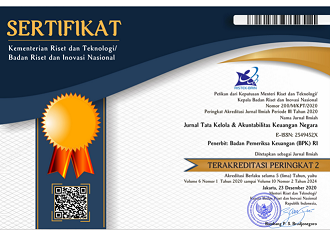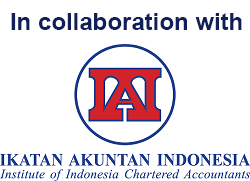EFEKTIVITAS PENGENDALIAN INTERNAL, AUDIT INTERNAL, KARAKTERISTIK INSTANSI DAN KASUS KORUPSI (STUDI EMPIRIS DI KEMENTERIAN/ LEMBAGA)
DOI:
https://doi.org/10.28986/jtaken.v2i1.35Keywords:
korupsi, pengendalian internal, peran audit internal, ukuran kementerian/lembaga, kompleksitas kementerian, corruption, internal control, the complexity of the ministryAbstract
This study investigates the effect of internal control effectiveness, the role of internal audit, internal audit authority level, the size of the internal audit, the size and complexity of the institution against corruption in the ministries/agencies in Indonesia. Effectiveness of internal controls seen from the number of internal control findings in the audit report of BPK, while the role of internal audit in an agency's internal control conducted by proxy with the number of findings of noncompliance in the audit report of BPK. The characteristics of institution seen from size and complexity of ministries/ agencies. The dependent variable is the corruption in the ministries/ agencies seen from the number of cases of corruption in the ministries/agencies in 2012-2014. This study used secondary data with samples of 249 ministries and agencies in Indonesia. The results show that the effectiveness of internal control, internal audit authority level form the organizational structure of the internal audit echelon I effect in reducing corruption. Total budget (in Rupiah) has positive effect on corruption. While the number of findings of non-compliance in the audit report of BPK, the number of internal auditors and the number of work units in ministries/agencies does not affect corruption.
Abstrak
Penelitian ini meneliti pengaruh antara efektivitas pengendalian internal, peran audit internal, tingka kewenangan audit internal, ukuran audit internal, ukuran dan kompleksitas instansi terhadap korupsi di kementerian/lembaga di Indonesia. Efektivitas pengendalian internal dilihat dari jumlah temuan pengendalian internal yang ada di laporan hasil pemeriksaan BPK, sedangkan peran pengawas pengendalian internal dalam suatu instansi dilakukan oleh audit internal diproksikan dengan jumlah temuan ketidakpatuhan dalam peraturan perundang-undangan hasil pemeriksaan BPK. Karakteristik instansi dilihat dari ukuran dan kompleksitas kementerian/lembaga. Variabel dependen yaitu korupsi pada kementerian/lembaga dilihat dari jumlah kasus korupsi pada kementerian/lembaga pada tahun 2012-2014. Penelitian ini menggunakan data sekunder dengan sampel 249 kementerian dan lembaga di Indonesia. Hasil penelitian menunjukkan bahwa efektivitas pengendalian internal, tingkat kewenangan audit internal berupa struktur organisasi audit internal setingkat eselon I berpengaruh dalam menurunkan kasus korupsi. Total anggaran (dalam Rupiah) berpengaruh positif terhadap kasus korupsi. Sedangkan jumlah temuan ketidakpatuhan dalam peraturan perundang-undangan hasil pemeriksaan BPK, jumlah auditor internal dan jumlah satuan kerja pada kementerian/lembaga tidak mempengaruhi korupsi.
References
American Institute Certified Public Accountant (AICPA), (2002). Statement on Auditing Standards No.99: Consideration of Fraud. Diakses dari www.aicpa.org.
Badan Pengawasan Keuangan Pembangunan, (2014a). Profil Auditor Per 30 Juni 2014. Diakses dari www.pusbinjfa.bpkp.go.id/halaman/16.
Badan Pengawasan Keuangan Pembangunan, (2014b). Meningkatkan Kompetensi APIP dengan Diklat Auditor Ahli. Diakses dari www.pusbinjfa.bpkp.go.id/bali/berita/read/11845/25.
Baltagi, B. (2005). Econometric Analysis of Panel Data. Third Edition. John Wiley & Sons.
Baltaci, M., & Yilmaz, S. (2006). Keeping an Eye on Subnational Governments: Internal Control and Audit at Local Levels. The International Bank for Reconstruction and Development/ the World Bank. The USA. Stock No. 37257.
Blume, L. & Voigt, S. (2011). Does the organizational design of supreme audit institutions matter? A cross-country assessment. European Journal of Political Economy, 27, 215-229.
Chabrak, N. & Daidj, N. (2007). Enron: Widespread Myopia, Critical Perspectives On Accounting, 18, 539-557.
Chatterjee, S. (2003). Enron's Incremental Descent into Bankruptcy: A Strategic and Organisational Analysis, Pergamon: Long Range Planning (LRP), 36, 133-149.
Chetwynd, E., Chetwynd, F., & Spector, B. (2003). Corruption and Poverty: A Review of Recent Literature. Management Systems International. Washington DC. USA
Cressey, D. R. (1953). Application and Verification of The Differential Association Theory. Journal of Criminal Law and Criminology, 43. 43-52.
Dewi, G. A. K. (2014). Pengaruh moralitas individu dan pengendalian internal pada kecurangan akuntansi (studi eksperimen pada pemerintah daerah Provinsi Bali). Program pascasarjana Universitas Udayana. Thesis.
Diamond, J. (2004). The Role of Internal Audit in Government Financial Management: An International Perspective. IMF Working Paper.
Ekasani, W. P. (2015). Pengaruh desentralisasi fiskal dan akuntabilitas laporan keuangan terhadap tingkat korupsi pada pemerintah daerah di Indonesia. Program Pascasarjana universitas Indonesia. Thesis.
Erlina & Mulyani, S. (2007). Metodologi penelitian bisnis untuk akuntansi dan manajemen. Edisi 1, Medan: USU Press.
Fauzi, A. N. (2013). Pendidikan Kewarganegaraan. Diakses dari www.modul.mercubuana.ac.id.
Fisman, R., dan R. Gati, 2001. Decentralization and corruption: Evidence across countries. Journal of Public Economics, 83, 867-893.
Ge, W., Li, Z., Liu, Q., & McVay, S. (2014). The Effect of Internal Control on Corporate Corruption: Evidence from China. National Natural Science Foundation of China Project Nos. 71332008.
Greene, H. W. (2002). Econometric Analysis. New York University.
Gujarati, D. N. (2003). Basic Econometrics (4th Edition). New York McGraw-Hill.
Gupta, S., Hamid, D., & Rosa, A. T. (1998). Does Corruption Affect Income Equality and Poverty?. IMF Working Paper 98/76.
Gupta, S., Hamid, D., & Erwin, T. (2000). Corruption and the Provision of Health Care and Education Services. IMF Working Paper 00/116.
Javaid, U. (2010). Corruption and Its Deep Impact On Good Governance In Pakistan. Pakistan Economic and Social Review, 1, 123-134.
Johnston, M. (2000). Corruption and Democracy: Threats to Development, Opportunities for Reform. Paper prepared for Department of Political Science, Colgate University.
Kaufmann, D., & Kraay, A. (2002). Governance Matters II, Updated Indicators for 2000/01. World Bank Policy Research Working Paper 2772.
Kongrungchok, A., & Stanton, P. (2014). Limitations of Thai Local Government Internal Auditing in Detecting Risks. Proceedings of the First Asia-Pacific Conference on Global Business, Economics, Finance and Social Sciences (AP14Singapore Conference) ISBN: 978-1-941505-15-1. Paper ID: S454.
KPMG. (2013). KPMG Forensic Survey of fraud, bribery, and corruption in Australia and New Zealand 2012.
Kuncoro, A. (2002). Corruption and Economic Growth in Indonesia. Ekonomi Dan Keuangan Indonesia, XLX (1).
Komisi Pemberantasan Korupsi Republik Indonesia. (2015). LaporanTahunan KPK Tahun 2014.
Komisi Pemberantasan Korupsi Republik Indonesia. (2014). LaporanTahunan KPK Tahun 2013.
Komisi Pemberantasan Korupsi Republik Indonesia. (2013). LaporanTahunan KPK Tahun 2012.
Komisi Pemberantasan Korupsi Republik Indonesia. (2012). LaporanTahunan KPK Tahun 2011.
Komisi Pemberantasan Korupsi Republik Indonesia. (2011). LaporanTahunan KPK Tahun 2010.
Komisi Pemberantasan Korupsi Republik Indonesia. (2010). LaporanTahunan KPK Tahun 2009.
Komisi Pemberantasan Korupsi Republik Indonesia. (2013). Selenggarakan seminar nasional, KPK dorong optimalisasi aparat pengawas internal. Diakses dari www.kpk.go.id/berita/siaran-pers/1519-selenggarakan-seminar-nasional-kpk-dorong-optimalisasi-aparat-pengawas-internal.
Kuncoro, M. (2011). Metode Kuantitatif (Teori dan Aplikasi untuk Bisnis dan Ekonomi). Yogyakarta: UPP AMP YKPN.
Lembaga Administrasi Negara dan Badan Pengawasan Keuangan dan Pembangunan. (2000). Akuntabilitas dan Governance. Modul 1 dari 5 Modul Sosialisasi Sistem Akuntabilitas Kinerja Instansi Pemerintah. Jakarta.
Li, J. T., Miao, L. Q., & Liang, Y. H. (2011). An empirical study on operating effects of accountability audit. Auditing Research, 3, 24-30.
Liu, J., & Lin, B. (2012). Government auditing and corruption control: Evidence from China's provincial panel data. China Journal of Accounting Research, 5, 163-186.
Masyarakat Transparansi Indonesia. (2002). Supermasi Hukum, Modul, Jakarta.
Ma, S. G. (2007). Empirical research on the effect of government auditors' qualities on audit performance. Auditing Research, 3, 24-29.
Mauro, P. (2002). The Effects of Corruption on Growth and Public Expenditure. Chapter 20 in Heidenheimer and Johnston.
Mardiasmo. (2006). Perwujudan Transparansi dan Akuntabilitas Publik melalui Akuntansi Sektor Publik: Suatu Sarana Good Governance. Jurnal Akuntansi Pemerintah, 2(1).
Nachrowi, N. D. (2012). Pendekatan Populer dan Praktis Ekonometrika untuk Analisis Ekonomi dan Keuangan, Lembaga Penerbit FE UI.
Organization for Economic Co-operation and Development (OECD). (2007). Annual Report of European Central Bank in 2004: Glossary of Statistical Terms, United Nations Statistical Division's Dated Dictionary of Official Definitions, Paris, 150-151.
Peraturan Presiden Nomor 55 Tahun 2011. (2011). Strategi nasional pencegahan dan pemberantasan korupsi jangka panjang 2012-2025 dan jangka menengah tahun 2012-2014.
Peraturan Menteri Negara Pendayagunaan Aparatur Negara Nomor : PER/05/M.PAN/03/2008 tentang Standar Audit Aparat Pengawas Intern Pemerintah.
Political & Economic Risk Consultancy. (2015). Asian Intelligence, An Independent Fortnightly Report on Asian Business and Politics. 920. 1. Diakses dari http://www.asiarisk.com.
Quah, J. S. T. (2007). National Integrity Systems in East and Southeast Asia 2006 Regional Overview Report. Berlin: Transparency International, 267-291.
Ricard, P. (2009). Report of the Chairman of the Board of Directors on Internal Control and Risk Management of Pernod
Ricard in France, Journal of Corporate Governance and Internal Control (Reference Document 2008-2009), 15-34.
Rahahleh, M. (2011). The Impact of Multiple Authorities that Conduct Internal Control on Public Fund in the Control Process in Jordan, European Journal of Economics, Finance, and Administrative Sciences, 28, 44-60.
Sandholtz, W., & Koetzle, W. (2000). Accounting for Corruption: Economic Structure, Democracy, and Trade. International Studies Quarterly: Blackwell Publishing and The International Studies Association: JSTOR, 44(1), 31-50.
Skounsen, C. J. R. K. R., Smith, & Wright, C. J. (2009). Detecting & Predicting Financial Statement Fraud: The Effectiveness Of The Fraud Triangle & SAS No.99. Corporate Governance & Firm Performance Advance In Financial Economics, 13, 53-81.
Srichunpech, S. (2005). The Roles of Internal Auditors with Fraud in Organizations. Journal of Business Chulalongkorn Criticisms, 104(2) (April-June), 48-59.
Sugiyono, (2009). Metode Penelitian Bisnis (Pendekatan Kuantitatif, Kualitatif, dan R&D), Alfabeta, Bandung.
Transparansi Internasional Indonesia. (2015). Setiap Tahun Indeks Korupsi Indonesia Meningkat. Diakses dari www.ti.or.id.
United Nations Development Program System Task Team The Post-2015 UN development agenda. (2012). Governance and Development.
Undang-Undang Nomor 31 Tahun 1999 tentang Pemberantasan Tindak Pidana Korupsi.
Undang-Undang Nomor 39 Tahun 2008 tentang Kementerian Negara.
World Bank. (2000). Anti-Corruption in Transition: A Contribution to the Policy Debate.
Widarjono, A. (2009). Ekonometrika Pengantar dan Aplikasinya. Edisi Ketiga. Yogyakarta: EKONISIA.
Winarno, W. (2007). Analisis ekonometrika dan statistika dengan E-views. Yogyakarta: UPP STIM YKPN.
Wijajanto, B. (2015). Pengantar Korupsi di Indonesia: Trend dan Tantangan Implikasi Kebijakan Kedepan. Diakses dari ti.or.id/cpi/materi_kpk.pdf .
Zang, Y., Zhou, J., & Zhou, N. (2007). Audit Committee Quality, Auditor Independence, and Internal Control Weaknesses. Journal of Accounting and Public Policy, 26. 300-327.
Zhao, J. S. (2005). An Analytical Framework for Government Audit Quality Characteristics in China. Auditing Research, 4, 65-68.
Downloads
Submitted
Accepted
Published
How to Cite
Issue
Section
License

Jurnal Tata Kelola dan Akuntabilitas Keuangan Negara is licensed under
a Creative Commons Attribution-ShareAlike 4.0 International License















